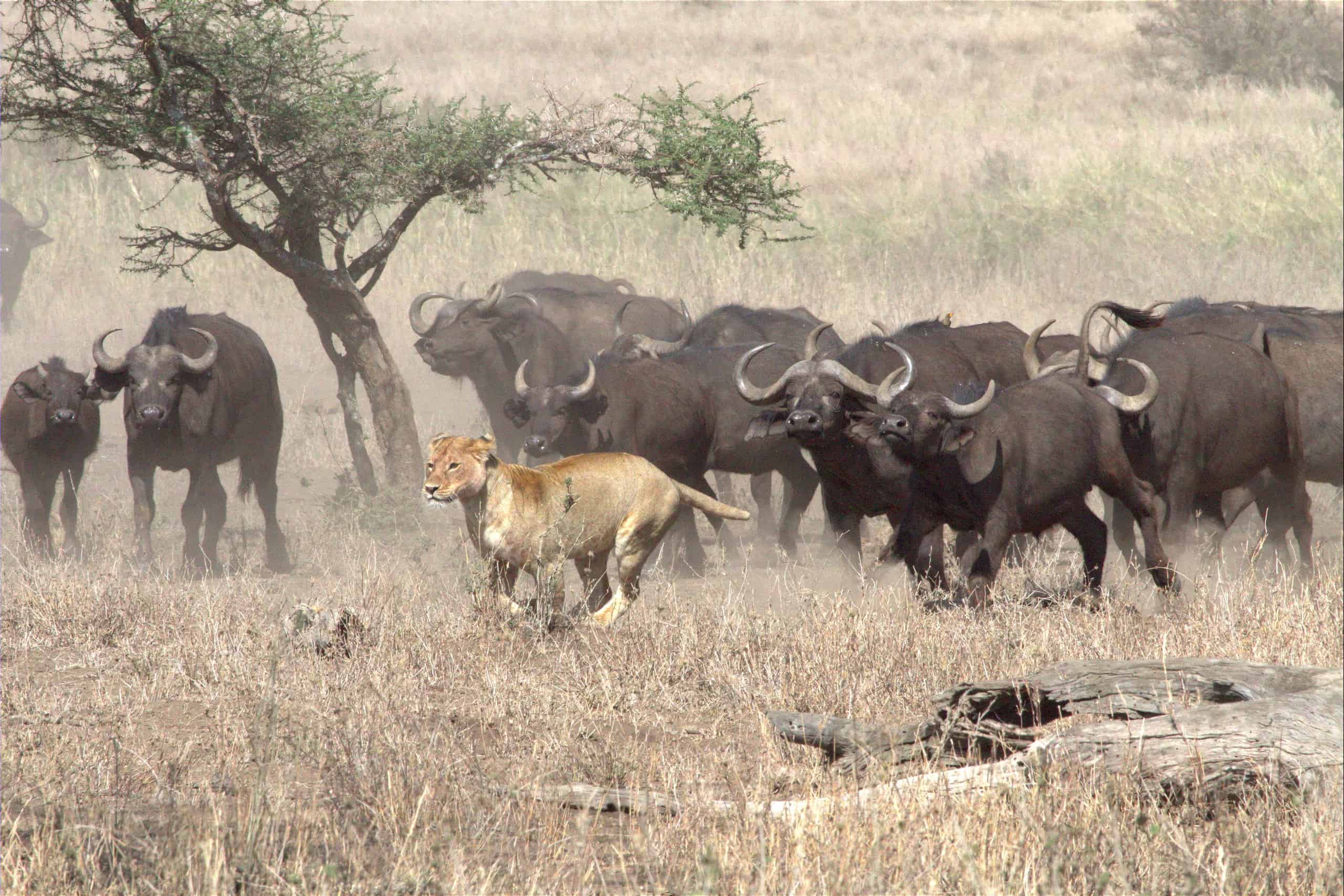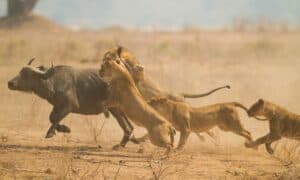This short video shows the truth of safety in numbers. It features a single cape buffalo as it wrestles with a lioness that hangs from its nose, trying to suffocate it. She hangs on tight despite the groans and thrashing of the massive beast. It’s not until the one buffalo circles around and charges that she loses her grip. That’s because the rest of the herd follows the first and turns around also. Knowing she is outnumbered, the lioness retreats, and the buffalo lives to see another day.
Watch the Short Clip of Lion vs. Buffalo Herd Below!
Let’s learn more about herd mentality in animals and humans!
What is Herd Mentality?
According to the Merriam-Webster dictionary, herd mentality is “the tendency of the people in a group to think and behave in ways that conform with others in the group rather than as individuals.”

A stampede is an example of herd mentality that involves the herd running blindly after one another. Stampedes are usually caused when a single or a few animals in the herd perceive a threat and run.
©iStock.com/andyschar
Often, we see this type of herd behavior among humans when a disastrous event occurs. An example of this can be a fire in a building. Due to the panic a fire causes, humans tend to forget all their senses and follow the mass of people as they try to escape danger.
Herd animals, like the cape buffalo in our video, also display herd mentality. As we see, one animal turns back toward the lion attack, and the others follow suit. Regardless of the danger, their instinct to stick with the herd overrides their fear. This time, this behavior benefits them. However, this is not always the case.
When is Herd Mentality Dangerous?
During times of panic, animals (including humans) typically don’t behave rationally. Herd mentality is a heavily studied phenomenon in both humans and other animals. When the goal is to escape from danger, this herd behavior frequently becomes dangerous. Let’s review some examples.

Ants swarming food or intruders is another example of herd mentality. They follow each other to the food/threat.
©Victor Suarez Naranjo/Shutterstock.com
A Study on Herd Behavior in Ants
A study at the University of Havana found that ants display both herd mentality and another phenomenon called symmetry breaking. Two types of experiments took place in the study.
The First Experiment Type – No Panic
The first type involved ants confined in a small space together. Then, two exits were presented equal distances from the center. The ants calmly found their way to the exits. About 50% of them dispersed through each door. Therefore, the ants exited with symmetry. No panic was noted.
The Second Experiment Type – Panic
When researchers repeated the experiment, they added ant repellant to the center of the confinement space before opening the doors. They witnessed the ants suddenly preferred one exit over the other by about a 60% margin. That’s the meaning of symmetry breaking.
Interpretation
In the end, research revealed that ants exhibit a collective fear that leads to herd behavior. Ants are relatively small creatures and rarely cause damage to one another by walking on each other. However, can you imagine if a similar experiment occurred with larger animals like cape buffalo? Their immense weight, sharp horns, and hard hooves have the potential to cause significant harm to one another. If one animal fell, the others might trample over it and kill it. The bodies of the deceased would then block the way for others and panic would grow.
The Salem Witch Trials
A prime example of herd mentality in humans comes from the Salem Witch Trials. This series of prosecutions and murders of people suspected of using witchcraft occurred in what is now Massachusetts between 1692 and 1693. Also called mob mentality, this phenomenon led to people jumping on the bandwagon to accuse others so they did not become targets themselves. Regardless of whether the people believed in witches or that the accused should be killed, they abandoned their own rational thoughts and beliefs in order to live. The Salem Witch Trials led to death of 25 innocent men, women, and children. This is perhaps one of the most extreme cases of herd mentality in human history. Although some scholars theorize that this phenomenon played a huge part in Adolf Hitler’s Holocaust, as well. Brandi J. Lopez’s 2016 master’s thesis explores her views on this theory.

Elephants form circles around their young, birthing mothers, and injured friends to protect them.
©imageBROKER.com/Shutterstock.com
When is Herd Mentality Helpful?
Now that we’ve learned some instances in which herd mentality can be dangerous, let’s explore some cases where it’s helpful.
Animals
We already discussed that this behavior saved the life of the buffalo in our video. Examples like this are the most common representation of positive herd mentality. Most herd animals, like elephants and wildebeest, use the herd to protect the young. They often keep babies in the middle of the herd. In fact, elephants regularly gather around females giving birth to protect her and the baby during their most vulnerable time. This type of herd mentality protects the babies and allows for species survival.
Humans
When humans come together to accomplish a common goal, this may be viewed as a positive example of herd mentality. A good illustration of this is the coming together of people after natural disasters. When fires, floods, earthquakes, or hurricanes devastate an area, other people frequently band together to help. This herd mentality involves our desire to help those like us. Many people gather food, supplies, and donations to help the affected communities recover.
Other human examples include rallying for social movements to encourage change or when communities come together to complete volunteer or charity work.
Final Thoughts on Herd Mentality
Although herd mentality often gets a bad reputation, we learned that sometimes it benefits the herd. Whether the herd is made up of animals or people, good things can come of it. However, herd mentality during times of panic can also be very dangerous. Have you ever experienced this phenomenon?
Thank you for reading! Have some feedback for us? Contact the AZ Animals editorial team.








